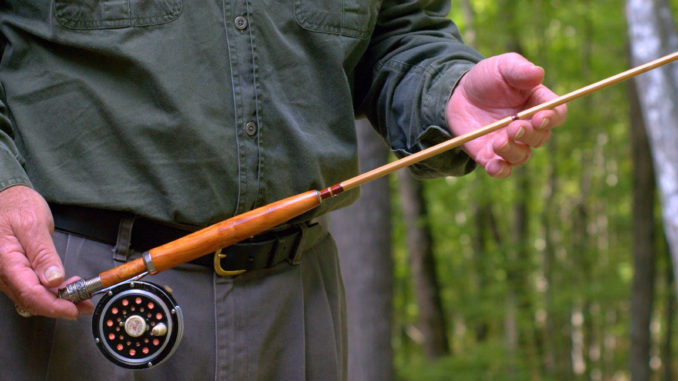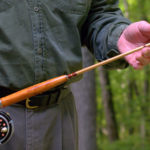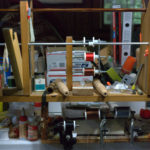
Rod-builder has 40 years under his belt
Jim Mills has been plying his trade for more than 40 years, meticulously handcrafting one-of-a-kind fly rods from graphite and bamboo, using only the best materials available to create what many of his customers describe as works of art.
Mills built his first rod for his father for bream fishing in 1964. “It was a disgrace,” Mills said, but his father didn’t think so, nor did some of his father’s friends, who asked Mills to build them similar rods. Since then, he has concentrated mainly on fly rods, and he estimates he has built more than 2,500, selling them nationwide and in numerous foreign countries.
Working out of his home in Whittier, Mills not only builds rods, he also restores vintage rods and repairs damaged ones. When he restores a vintage rod, he prides himself on making that rod “come back alive.” Many of his restored rods look better and perform better than they did when new.
Mills works from blanks to build both graphite and bamboo rods. The goal is to keep costs reasonable. The beginning price for his bamboo rods is $450, but they would cost more than twice that if he had to build them from scratch, a process that takes anywhere from four to six weeks. He usually has three to four rods in various stages of process at one time.
Most of the hardware for his rods — ferrules, butt guides and reel seats — are made of nickel silver, but he also stainless steel and titanium. Reel seats are hand-turned from hardwoods such as black ash and claro walnut and exotic woods from around the world. Agate is used to line the butt winds to ensure a smooth, drag-free delivery. Mills said agate is more durable than standard ceramic liners and does not develop grooves after repeated use. The exceptional line delivery creates less work for the fly-fisher.
“The rod should do all the work, not the fisherman,” he said.
For rod grips, Mills uses Portuguese cork, one of the best corks available.
Mills is a perfectionist when it comes to building rods. They must be perfectly balanced, and if blanks or other components are damaged even slightly during the process, they are discarded. Rods usually are built to a customer’s specifications as far as length, weight and number of sections. His most-popular rods are either 4- or 5-weight and 7 to 7 ½ feet long.
Each tip is tapered according to guidelines provided in Gould’s book of tips and tapers, the taper types established by and named for old-time master rod builders. Each rod he sells comes with a spare tip, a sock, an aluminum case and instructions for proper care of the rod also are included.
Blanks are finished with 4.0 bronze wool instead of sandpaper or steel wool, which can leave scratch marks. Guides, aka eyes, are mounted using superior 00 silk thread instead of nylon, which is standard in most commercial rods. Rods are then coated with Man of War marine spar varnish, which is much less susceptible to moisture damage than traditional coatings such as shellac. The rod is then buffed to a silky finish. A Mills rod is made to last a lifetime.
Although many of Mills’s rods are made with graphite blanks, he prefers bamboo for durability, performance and looks.
“Bamboo is more relaxed than graphite, and it does all the work.” he said. “If I could have only one rod, it would be bamboo with a Granger taper.”
To illustrate the durability of bamboo, he showed a 90-year-old bamboo rod that looked as if it had just been made.
“You probably won’t find graphite rods that last that long,” he said.
Mills uses only the best blanks available for his bamboo rods, Tonkin cane from China, considered the best bamboo for fly rods on the market.
Many of his rods are built using standard patterns, but he’s not reluctant to experiment. In his stock of rods, he had one that was feather light. He also had rods with curved tapers.
“I’ll try anything new,” he said, but it has to work. Before he puts a new style of rod on the market, he fishes with it first to make sure it performs to his strict standards.
One of the newer styles of rods he is making is what he calls a “hexagraph” — a 6-sided graphite rod that has the look and feel of a bamboo rod.
“To me, it’s the Cadillac of graphite rods,” he said, “and very expensive.”
Mills has a website, www.ravenforkrods.com, which shows photographs of some of his work and provides information about his rod-building business.






Be the first to comment